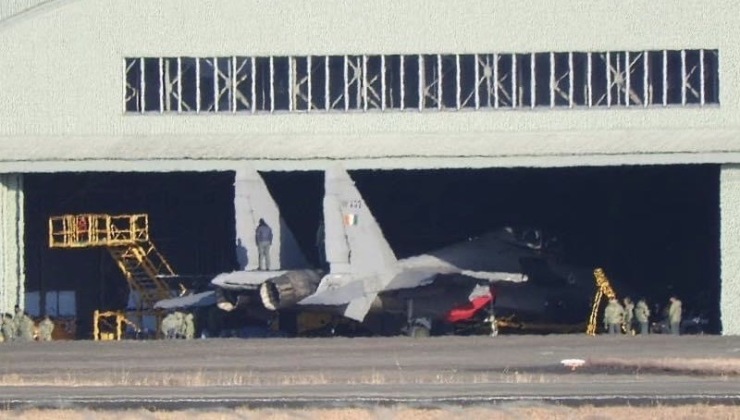News
Russian Built Su-30 Fighters Conclude Unprecedented Deployment to Japan: Implications of Veer Guardian 2023

On January 10 Russian built Su-30 fighter jets landed on Japanese soil at Hyakuri Air Base, 130km north of Tokyo, marking the first ever deployment of Russian or Soviet aircraft to the East Asian country. Flown by the Indian Air Force, which is the world’s largest operator of the Su-30 and uses the enhanced and heavily customised Su-30MKI variant, four of the aircraft were dispatched to Japan to participate in the Veer Guardian exercises from January 12-26. The long ranged Russian jets made transit stops in Thailand and the Philippines, and were accompanied by two Indian Air Force C-17 Globemaster III transport aircraft and an Il-78 tanker jet. The exercises are significant as they reflect not only the expansion of defence ties between Delhi and Tokyo, but also a unique opportunity for Japan’s armed forces to analyst the capabilities of enhanced Russian heavyweight fighters – the intelligence from which is almost certain to be passed on to the Untied States. The Su-30 is a derivative of the Su-27 Flanker heavyweight air superiority fighter, which is widely considered the most capable fighter class fielded by any air force during the Cold War. Not only is the Su-30 itself very widely fielded by Russian strategic partners, from China and Myanmar, to Belarus and Algeria, but other Flanker derivatives, many of them significantly more advanced, are even more widely deployed and form the backbones of the Russian and Chinese fighter fleets today.
Over 270 Su-30MKIs are currently in service in the Indian Air Force, with the first becoming operational in 2002 and the last order for new units placed in 2020. The aircraft was heavily customised and enhanced using technologies from the cancelled Su-27M and Su-37 air superiority fighters in the 1990s, including the Su-37’s N-O11M radar and the Su-27M’s controlled canards, AL-31FP engines and thrust vectoring nozzles. The fighter was one of the very first in the world to integrate an electronically scanned array radar, and was the very first operational fighter to benefit from thrust vectoring engines providing extreme manoeuvrability. Widely considered the most capable fighter in the world at the time, the Indian jets very comfortably outperformed the U.S. Air Force’s top fighter the F-15, as well as lower end F-16s, in multiple red on blue simulated combat exercises from the early 2000s. Su-30MKIs deployed to Japan have reportedly been drawn from the Indian Air Force’s No. 220 Squadron based at Halwara in the northern state of Punjab, and will exercise alongside Mitsubishi F-2 single engine lightweight fighters from the Japanese Air Self Defence Force’s 7th Air Wing and the F-15J Eagle heavyweights from the Air Tactics Development Wing – Japan’s aggressor unit assigned to simulate the capabilities of enemy aircraft during training.

The Su-30MKI is expected to very comfortably outperform Japanese F-15s, as while the aircraft represents a heavily enhanced variant of the Flanker, Japanese Eagles by contrast are some of the oldest in the world and still rely on effectively obsolete mechanically scanned array radars. Many Japanese F-15 units also still rely on Cold War era AIM-7 missiles for air to air combat, which lack active radar guidance – seriously limiting their effectiveness. The aircraft also lack high off boresight targeting capabilities, meaning in air to air combat they cannot engage targets without pilots physically pointing the F-15’s nose towards it. These differences in avionics and weaponry are supplemented by the Su-30’s much higher endurance and manoeuvrability. The Mitshbusihi F-2, an enhanced derivative of the American F-16, is a significantly more modern aircraft with an electronically scanned array radar that entered service in the same year as the Su-30MKI. Although broadly on par in terms of avionics, however, the much lighter aircraft is limited by the small size of its radar and much lower weapons payload as well as its much lower thrust/weight ratio. Nevertheless, with India unlikely to face F-15s in combat, while Japan faces hundreds of Flankers on its borders deployed by both China and Russia, lessons from simulated engagements have the potential to be significantly more useful to the Japanese side than to their Indian counterparts.

Japan is expected to modernise its fighter fleet by enhancing a portion of its F-15s with next generation avionics, including electronically scanned array radars and AIM-120D air to air missiles. It will also continue to commission F-35 fifth generation fighters into service, with these having already replaced its older F-4 jets from the 1970s. India is also set to modernise the Su-30MKI with a new generation of sensors, and possibly with AL-41 engines from the Russian Su-35S providing three dimensional thrust vectoring and greater endurance, manoeuvrability and fuel efficiency. India is also considered a leading client for the successor to the Flanker series, the Su-57 Felon, and has repeatedly expressed an interest in acquiring the aircraft once it has been more widely fielded by and tested in the Russian Air Force itself. Production models of the fighter first saw combat in 2022, and have carried out operations no other aircraft of their generation have, with that year also marking their first of high rate serial production.
Russia previously attempted but failed to gain Indian investment in a joint program to develop a specialised Su-57 derivative, although joint development was arguably far from feasible at the time as the large majority of development work on the fighter had already been completed by Russia alone. Both Japan and India are under pressure to modernise their fleets to a fifth generation level in the face of neighbouring China’s fast growing and increasingly sophisticated fifth generation fleet, with the Chinese J-20 fighter being the only one of its generation both in production and fielded at squadron level strength other than the American F-35. The aircraft leaves both the F-15J and the Su-30MKI effectively obsolete by comparison, and is in production on a larger scale than any other twin engine fighter in the world.












